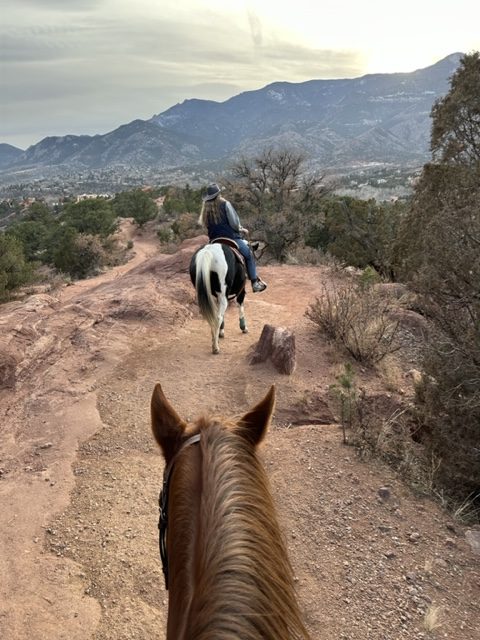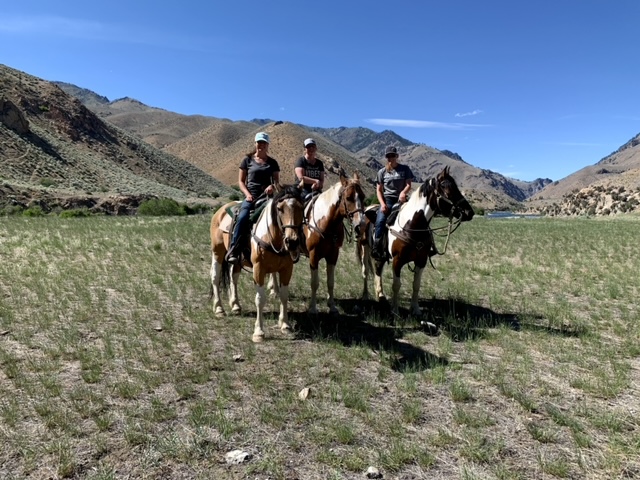The days are getting longer, the snow on the ground is FINALLY melting off, and spring is in the air… which means trail riding season is just around the corner!
Trail riding is an excellent activity to share with your horse. Whether you are taking a backcountry trip for several days or hauling down to the local open space for an afternoon, proper preparation helps ensure a safe and enjoyable experience!
Here are a few things to keep in mind as you prepare for trail season:

Conditioning
Before embarking on a trail ride, it is important to make sure that your horse is in adequate physical condition. For many of us, winter is a quiet time with minimal riding. We certainly wouldn’t expect ourselves to be able to go from several months off to running a marathon, would we? Make a plan for your summer trips and assess the potential difficulty of your chosen routes. Are you going to be riding the gentle creekside trails at Bear Creek Lake Park, scaling the rocky mountainside at Staunton State Park, or taking off for several days in the backcountry of Rocky Mountain National Park?
Determine approximate length and difficulty of your desired rides and begin working on a conditioning plan. If you haven’t been working your horse all winter, start with short, light to moderate intensity rides. Start building up time and adding in more technical work. For horses who are intended to be used on mountainous trails, add in exercises designed to strengthen the hind end and stifles – such as hill work, backing, working over ground poles, and cavalettis. Build your horses’ stamina and fitness by increasing the time you spend in a proper trot and balanced lope/canter.
Equipment
For the safety and comfort of both you and your horse, always check your equipment prior to usage. Many horses fluctuate in weight and musculature over the winter, so start by ensuring your saddle fits appropriately and you have a proper pad that will wick away excess moisture and prevent rubbing.
If you are planning on riding rocky terrain, I recommend considering shoes or trail boots. While some horses have hard enough feet and do not require additional support, it is a good idea to have a properly fitting pair of trail boots in case of an emergency or soreness on the trail.
Consider other equipment that you may be using during rides – are you going to be donning a new pair of snazzy saddle bags? Tying a rain slicker to the back of your saddle? Prior to heading down the trail, be sure to expose your horse to all of these things in a comfortable and familiar setting. You do not want to learn that your horse does not tolerate saddle bags moving around on their back when you are trying to enjoy a breezy lope through the open field at Dawson’s Butte!

First Aid Kit
It is important to build a first aid kit to bring with you on rides. Depending on the length of the ride, I generally carry a small, abbreviated kit for the ride itself (generally a few select meds, some bandage material, hoof pick, etc.), and have a more extensive kit back in the trailer. Be sure to have a kit for BOTH your horse and yourself! As always, do not hesitate to reach out to your veterinarian to discuss an appropriate first-aid kit for your horse.

Trailer
If your trailer has been sitting all winter and you plan to haul to various trails, be sure to give it a thorough once-over prior to hitting the road. Be sure to check your floors, bearings, brakes, tires, and electrical. It may also be beneficial to schedule an annual maintenance appointment with your local trailer shop.
Paperwork
While most trail systems do not have specific vaccination or paperwork requirements, whenever you are traveling with your horse, it is important to have appropriate documentation. This may include a current Coggins, health certificate, vaccination record, brand inspection, and microchip information. If you find yourself overnighting somewhere, some places may require one or multiple of the above-mentioned documents, so make sure to confirm any necessary paperwork prior to departing.
**Remember, in the state of Colorado, if you are traveling greater than 75 miles you are required to have a new brand inspection! One way to save money and time is to invest in a “permanent travel card” for your horse. This replaces the need for a new brand inspection every time you travel. In order to obtain a travel card, contact your local brand inspector.**

Water
Trail riding can be thirsty work, so ensure you have access to water for both yourself and your horses. Some trails have hydrants or running water sources, but some don’t. You may need to be prepared to haul in your own water! Be cautious of shared water sources as these can harbor infectious diseases. Toss a couple of clean buckets into your trailer and reserve them for your horses only.

Make a plan!
Take the time to research your desired destinations before heading out for your ride. Many trails are multi-use, so be prepared to run into bicyclists, hikers, dogs, and other riders. Additionally, be aware of the risks that may arise in each location – such as wildlife in the mountains or snakes in the rocky foothills. Find your trail online or use forums (or friends!) to gather information regarding parking, water, usage, and other amenities.
Whenever possible, find a friend or group to ride with. Let someone reliable know of your riding plans and an expected departure and return time.
If you are traveling outside of the range of your regular veterinarian, make a plan for emergency veterinary care – this may include calling local clinics and finding the closest one that may offer emergency services. Remember – many equine veterinary clinics are very busy right now, and many do not accept non-client emergencies. Some pre-planning may help identify a veterinarian who would be able to help in case of an emergency.
Most importantly, have fun and enjoy time in the great outdoors with your horse! Happy Trails!



